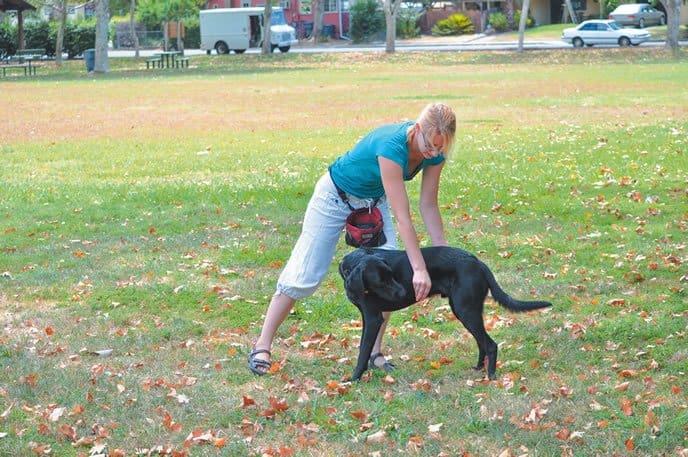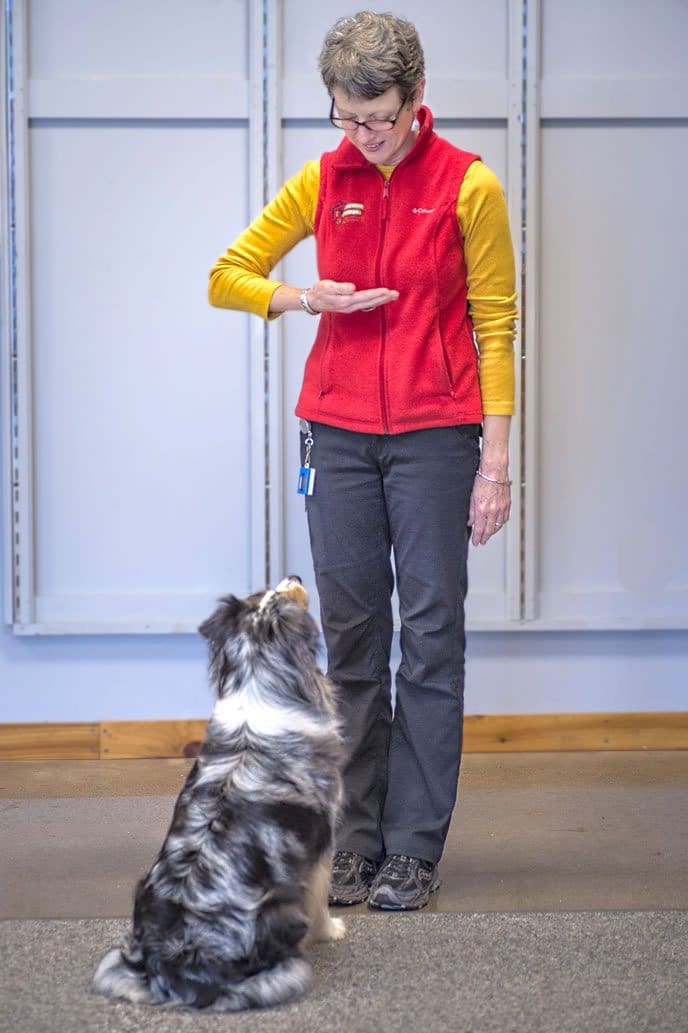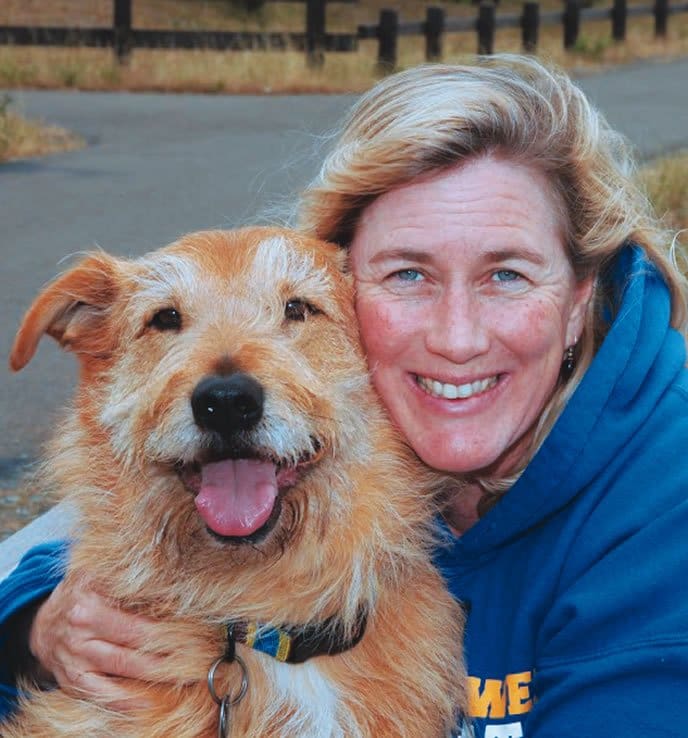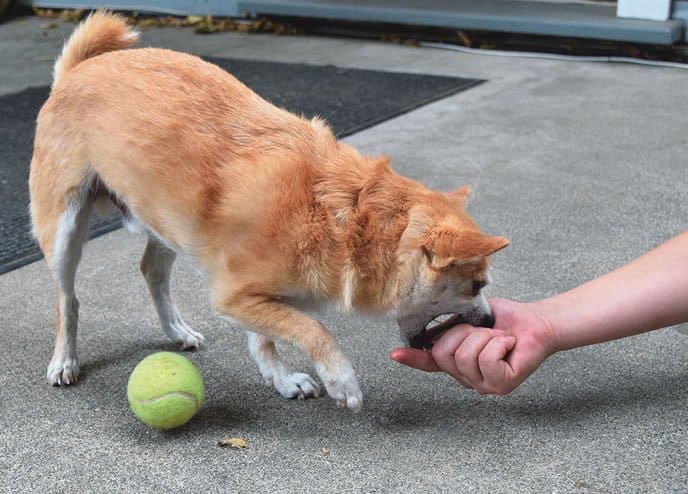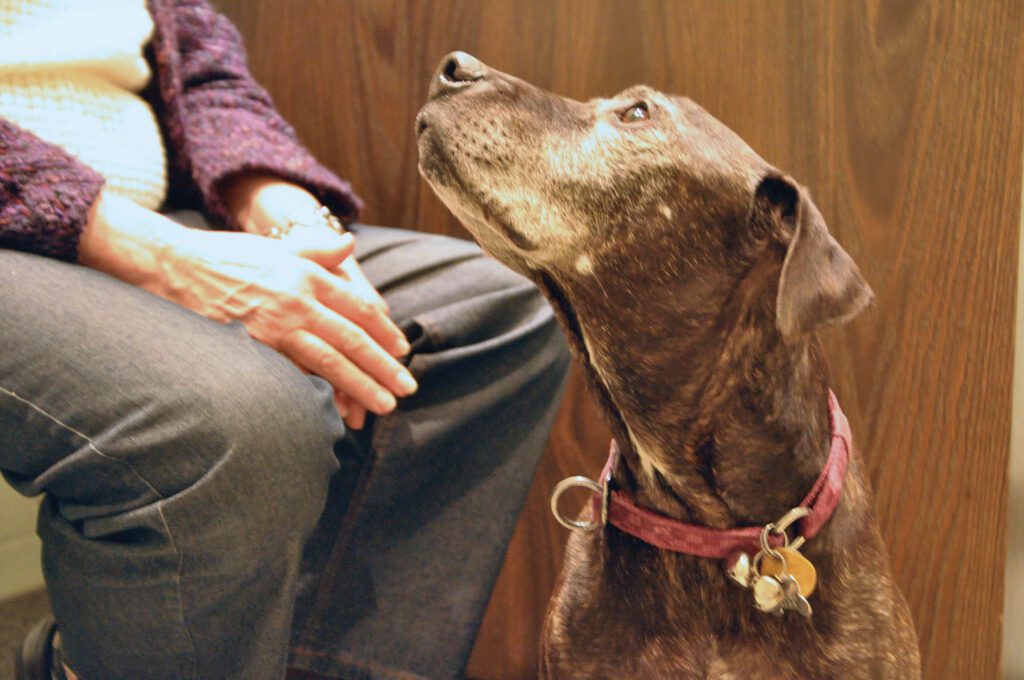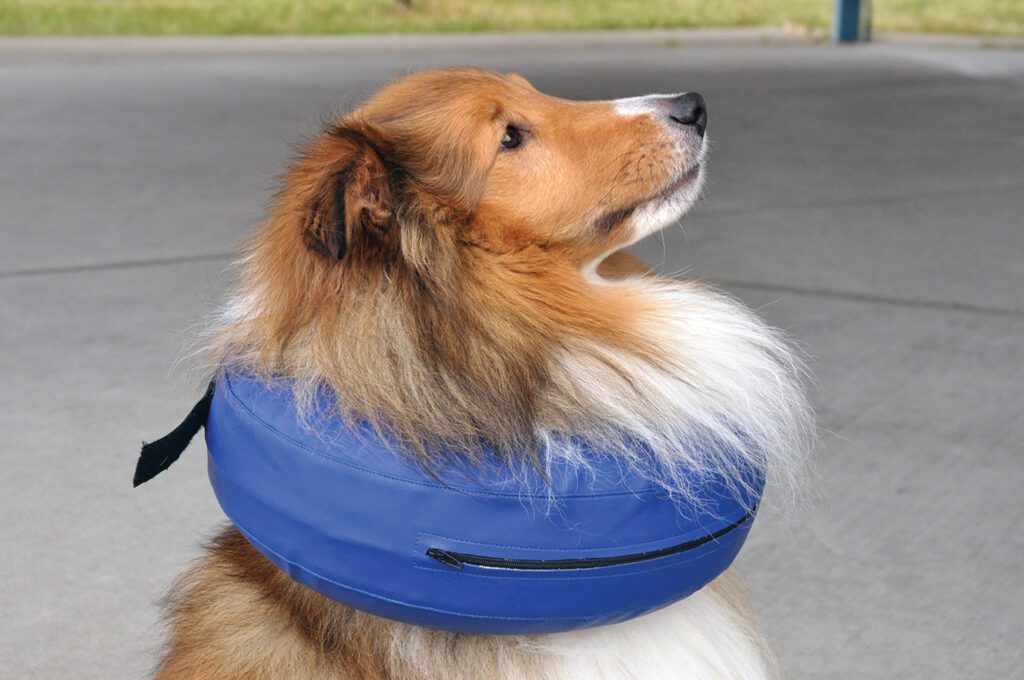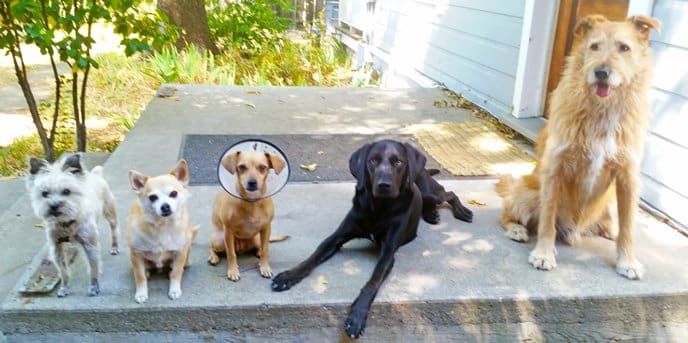Competing with our Sheltie Asta at her first agility trial was an answer to our prayers. After her diagnosis, we lived with months of uncertainty about what type of life she might have. Following her lovely debut, a friend aware of Asta’s condition commented on how “normal” it all looked. But our path to that first agility competition was anything but “normal” because Asta has a mental illness.
People very rarely discuss mental illness in dogs, even though many families face this situation. The silence on this topic hampers them from finding much needed help and support.
This is the article I wish had been available to us when Asta’s symptoms began – the story of one dog’s journey through mental illness.
Bright Beginnings
By June 2012, my husband Ken and I had been on puppy wait lists for more than a year. At our first encounter, 9-week-old Asta and I quickly connected, but I wasn’t sure if a dog of her petite size was the right fit for our family. When Ken and I visited her two weeks later, Asta chose us as much as we chose her, and we promised her a forever home.
Named after the crime-solving dog in “The Thin Man” movies from the 1930s and ’40s, Asta is our fifth Sheltie. We love the breed for their beauty, intelligence, and willingness to work with their people. Our first Sheltie introduced us to dog sports, and each of our dogs has earned performance titles. We hoped Asta would one day, too.
Our first weeks together were happy. Blessed with a sunny disposition, Asta loved to learn and was a star at puppy kindergarten. Our primary-care vet, Dr. Karen Hoffmann, borrowed a line from Mary Poppins to describe her: “Practically perfect in every way!” Asta enjoyed meeting new people and dogs. Very little bothered her.
Looking back, though, there were signs that something was amiss. Shortly after coming home, Asta periodically chased her tail (with one or two spins) during meal preparation. She also frequently licked our fireplace, even though I kept spraying it with Bitter Apple.
The list of odd behaviors grew along with Asta. At four months old, she often stared at one of our end tables for as much as 30 seconds at a time, although there was nothing unusual on or behind the table. Her tail-chasing in our kitchen increased, with one episode lasting more than 38 seconds. I made mental notes, but wasn’t particularly concerned.
Into the Abyss
In mid-September, 5-month-old Asta suddenly started taking every opportunity to race along our fenceline as if she was chasing something – but nothing was ever there. She would also chase after things that weren’t there during walks; she’d run straight up steep hills after figments of her imagination.
I assumed that these odd behaviors were just a training issue. But no training techniques helped, and our puppy class instructor had no suggestions. We didn’t want her repeating undesirable behaviors, so we kept trying to stop her.
I contacted acquaintances with experience in dog training and behavior, but didn’t find much help. While my first email inquiry mentioned the possibility of obsessive-compulsive disorder (OCD), I refrained from “diagnosing” the behavior myself, since I knew well there could be other explanations.
The frequency of Asta’s odd behaviors rapidly escalated. Her tail-chasing occurred more frequently, in more contexts, and in a specific pattern (four spins to the right, four to the left, then four to the right). Her chasing after invisible things moved indoors, where she paced along the baseboards as if hunting for something. Many times, when we stopped her chasing behaviors, Asta would suddenly focus on us as if to say, “Oh, you’re there!”
About a month after these odd behaviors started, I took Asta to our veterinarian for her routine six-month well-puppy visit. I showed video to our primary-care vet, but had difficulty explaining the symptoms because they made no sense. With such limited information, Dr. Hoffmann thought Asta’s quirks could be just a phase. If I remained concerned, it was her recommendation that I consult with certified dog training and behavior professional Pat Miller.
While my gut told me something was wrong – it was more than a phase – my work schedule couldn’t accommodate a consult with Miller. Instead, I arranged for a home visit by an Associate Certified Applied Animal Behaviorist. She thought that we might need help from a veterinary behaviorist – a veterinarian who specializes in behavior – but she gave us a prevention and management plan to try. In addition, she taught me to describe Asta’s symptoms in terms of duration, intensity, and frequency.
The behaviorist’s plan reduced Asta’s symptoms, but at significant cost. Because of the plan’s stringent restrictions, Asta was always stressed (like the whole family) and her world shrank. After two weeks, the behaviorist said Asta’s repetitive behaviors were “abnormal” and would return; she advised that we contact Dr. Hoffmann to get a veterinary behaviorist consult.
When Dr. Hoffmann called, we discussed Asta’s worrisome symptoms. She recommended several specialists, and then asked how I was doing. I said I felt somehow responsible for Asta’s problems, and she replied that is a common response when people see their pets suffer. Then she firmly and kindly stated that Asta’s issues were not my fault.
Since Asta’s symptoms were back and growing worse, I quickly set up a long-distance consult with Dr. Hoffman’s top recommendation: veterinary behaviorist Karen Overall, VMD, author of a textbook on small-animal behavior conditions. I rushed to pull together and overnight all of the information Dr. Overall requested. She expected the consultation would take two to three weeks to complete.
Asta’s descent into the abyss of uncontrollable, repetitive behaviors had been swift and inexorable. Her symptoms erupted around mid-September. By early December, she was on the verge of self-mutilation during tail-chasing, our house was barricaded to keep her from chasing invisible things along our baseboards, and we couldn’t walk her at any time of day or night (even for a short potty break) without her chasing things that weren’t there. We were desperate.
In mid-December Dr. Overall emailed her seven-page evaluation with 78 pages of attachments to Dr. Hoffmann and me. When the recommended ophthalmology consult and blood tests ruled out other medical conditions, Asta’s diagnosis was obsessive-compulsive disorder.
While much remains unclear about this complex disorder, OCD is currently believed to involve issues with brain circuitry and chemistry. Dr. Overall’s attachments and other resources helped us better understand OCD.
In OCD, normal dog behaviors, such as hunting, eating, and grooming, are repeated in excess (duration, intensity, frequency) and out of context. Common canine OCD behaviors include tail-chasing, fly-snapping, light-chasing, and licking. Hallucinations (as when Asta chased things that weren’t there) can be involved. The prevalence of OCD is estimated at 1 to 8 percent of the general dog population, but occurs more frequently in certain breeds (such as Bull Terriers and Dobermans) and lines.
While OCD can emerge in dogs as young as three months and into young adulthood (18-36 months), why it develops remains unclear. Many people believe that abuse, neglect, boredom, and stress cause OCD, which can lead to families being blamed for their dog’s illness (see “The Blame Game,” in the box, above right). However, even well-cared-for dogs, like Asta, can develop OCD. A genetic basis has long been suspected; two research studies identifying gene and gene variants in OCD dogs were published in 2010 and 2014.
With no single test for OCD, diagnosis is made by behavior history, observation of behaviors (either directly or by video), and ruling out other medical conditions. The differential diagnosis often includes epilepsy, dermatologic conditions, and gastrointestinal issues. Early diagnosis and treatment are critical; the more the dog has practiced OCD behaviors, the harder it is to extinguish them. Working with a board-certified veterinary behaviorist like Dr. Overall is vital, since these specialists have the training and expertise to diagnose and treat these conditions.
As Asta experienced, untreated OCD typically worsens. OCD behaviors can take hours of a dog’s time, interfere with quality of life, and lead to injury, such as bare spots from excessive grooming, bleeding paws from obsessive pacing, and bites during tail-chasing. Dogs can die from OCD, either due to self-inflicted injury or euthanasia for seriously problematic behavior.
There is no “magic bullet” to treat OCD, which is incurable and usually requires lifelong care. Treatment involves a combination of medication, behavior modification, and management. Certain antidepressants, like Prozac, are used to treat human and canine OCD. Behavior modification involves teaching the dog relaxation and self-calming skills, as well as behaviors incompatible with his OCD symptoms. Management entails controlling the environment (for example, avoiding OCD triggers). Prognosis varies from dog to dog, but is positively affected by owner commitment and early diagnosis and treatment.
The Tide Turns
The use of behavioral medications for dogs can be controversial. One common misconception is that these medicines turn dogs into glassy-eyed zombies. Instead, on medications Asta has become a bright-eyed, energetic dog fully engaged in life, rather than preoccupied with OCD behaviors most of the time.
Dr. Overall recommended two medications for Asta: clomipramine, an antidepressant that treats OCD; and gabapentin, an adjuvant therapy. She requested regular updates be sent to her and Dr. Hoffmann, so they could monitor Asta’s progress.
Within a week of starting gabapentin, Asta started cuddling with us again, resumed some normal play behaviors, and showed slight decreases in some OCD symptoms. As her clomipramine dose was increased to the therapeutic range, we saw additional subtle improvements. The tide was slowly turning.
With the medications taking effect, we began behavior modification. Asta and I spent 15 minutes a day doing Dr. Overall’s formal relaxation protocol. During walks Asta was reinforced for checking in with us or playing tug on her leash instead of chasing hallucinations. We rewarded sits and downs, behaviors incompatible with tail-chasing. We enrolled Asta in Control Unleashed, a class for “dogs with issues” that uses positive methods. Dr. Overall carefully monitored Asta’s progress and compassionately answered our questions.
We didn’t know what the future held for Asta. I never asked Dr. Overall for a prognosis because I was too afraid of the answer. I never set recovery goals for Asta to avoid putting pressure on her or feeling disappointed with her. Instead I kept trying each day to get a little more “normal” into our lives.
As Asta’s primary caregiver, I felt isolated and alone with her diagnosis. Experience taught me that I couldn’t tackle the complexities of OCD on my own, but needed help from experts. Instead of getting frustrated at my inability, I gently reminded myself, “Be unafraid to ask for help.”
Despite improvements over those first eight weeks of treatment, life with Asta was still difficult. She quickly lost control when she saw wildlife during walks, which exacerbated her OCD. She had many challenging attention-seeking behaviors. Our nerves were frayed from dealing with these issues on top of her OCD. “Be unafraid to ask for help,” I told myself as I scheduled a consult with Pat Miller, who had worked with and written about OCD dogs.
“What Now?”
In March 2013, Asta and I drove to Peaceable Paws, Pat’s facility in northwestern Maryland. Pat was compassionate, and empathized with the difficulties of living with Asta’s OCD. But she also expertly dissected Asta’s problem behaviors and had me commit to work her treatment plan. I felt renewed hope.
But there was an unexpected twist to our visit. As Pat commented that Asta’s affect was slightly flattened, I realized that I had noticed some recent mild sluggishness and inappetence. When I informed Dr. Overall, she explained that these mild symptoms could be due to re-regulation, a process where the body adjusts to medication. She was very supportive as she educated us on our options, including the complexities of switching medicines. Since Asta’s OCD symptoms were improving, we all agreed to continue with the medication regimen, but monitor closely.
Dr. Overall had warned us that OCD has lots of ups and downs, which I felt anew. After so much improvement, I feared Asta was losing ground. I tried sharing our experiences with people outside of our trusted network of specialists and friends and was told Asta needed a new home and I didn’t know how to handle her. I was very discouraged.
Out of the blue, a song helped me cope. “What now?” sang Stephen Curtis Chapman. “What will you do with this treasure you’ve found?” The lyrics reminded me how precious Asta is and encouraged me to keep trying.
After weeks of watchful waiting, the flattened affect, inappetence, and sluggishness from re-regulation abated. With Asta stabilized on medications, the 8-month-long acute crisis was finally over. Dr. Overall and I agreed that it was time to treat OCD as a chronic condition that we live with and manage.
In this new phase, we took to heart Pat’s advice to “make haste slowly.” Her point was that we shouldn’t rush change, but build a solid foundation. We continued with behavior modification, although sometimes it didn’t seem like much was happening.
But the tiny changes from the behavior modification added up. After 10 months of treatment, Asta’s tail- and hallucination-chasing symptoms had decreased significantly, and she was often choosing to self-calm. Their response was touching, a celebration for us all.
Doors of Opportunity
Many educational resources recommend getting OCD dogs involved in performance activities, like agility, to give them a healthy outlet. However, none explain how to do this to truly benefit the dog. While both Dr. Overall and Pat Miller expressed some concerns about agility for Asta, they agreed we could try it as long as I monitored her reactions.
In March 2013 Asta and I started an agility foundation class with a skilled instructor who let dogs learn at their own pace. Before the onset of OCD, Asta learned quickly, but in agility class she was often slow to master new skills. Any time I got discouraged, Ken calmly affirmed that he thought Asta could do it and helped with her training.
After nine months of agility training and a year of treatment, Asta clearly communicated that she wanted “more.” With a door of opportunity opening, I took her to practice sessions where she completed complicated obstacle sequences. Her instructor saw the improvements and moved her up a class level. When a classmate commented that Asta changed dramatically over a three-week period, I couldn’t explain why. Following her debut in January 2014, Asta’s agility career blossomed.
More doors opened. In March 2014 Asta became less focused on chasing her outdoor hallucinations, and instead of physically stopping her, I could successfully use Pat’s verbal positive interruptor technique. In May I was astonished to see her stopping the hallucinatory-chasing behavior before I could interrupt it! These changes enabled Asta to spend some supervised time off-leash in our fenced backyard, sunbathing, digging, and hanging out with us, just like our other dogs.
Even well-controlled OCD waxes and wanes. With ongoing medication, behavior modification, and management, Asta has experienced 80 to 90 percent symptom improvement since diagnosis. Now we get to focus on Asta, instead of her OCD.
Beauty for Ashes
OCD has cost us dearly. The symptoms were stressful and uncomfortable for Asta – and the rest of the family! The illness took over large parts of her life and ours. Since OCD rarely goes away completely, we must keep dealing with it. Asta will always experience certain OCD-related restrictions, which sometimes affect our other dogs. Being unfairly blamed for Asta’s illness also took its toll on us.
But on this side of the recovery process we see how we have been given beauty for ashes. With continued treatment Asta leads a high-quality life. Our bond with her has been strengthened from all that we have been through. Our lives have been immeasurably enriched by the care, kindness, and compassion Asta’s treatment team, family, and friends have shown us on this journey. Each day we experience the miracle of Asta’s recovery.
Oddly enough, OCD has taught me so much above love. Before she stabilized on medications, Asta’s behaviors were so difficult that many times I didn’t feel love toward her – or even like her. But as Fred Rogers (of “Mister Rogers’ Neighborhood”) once said, “Love isn’t a state of perfect caring. It is an active noun like struggle. To love someone is to strive to accept that person exactly the way he or she is, right here and now.” We struggled long and hard, and that reveals the depth of our love for Asta, OCD and all.
We have no idea where Asta’s journey will lead us next. But that journey would be incomplete if we didn’t share her story so that other families in similar situations know that they are not alone in the struggle.
Susan Klavon lives in Gaithersburg, Maryland, where she coordinates a county-wide project that provides holiday assistance to needy residents. Asta is working on her CPE and AKC agility championships.
